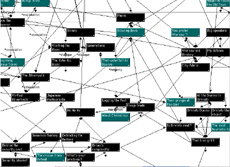About this text
This text discusses our places today, the cities and suburbs where we live and work. Critics say these aren't what they used to be, and this is true. Once solid "traditional" homes and places affirming and supporting our social identities may seem confusing and empty amid our multi-everything intersecting lives today. We can feel homeless or unroooted, thinned out.
Armed with a new theory about what makes an area of space into a place for human dwelling and arguing that old traditional places were never that solid, I want to talk with those critics. Are today's living places as unsatisfying as they say? Are sprawling suburbs, malls, theme parks so thin and inhumane compared to deeper, thicker historical towns and homes? Yes and no. My text examines what makes places rich and satisfying and finds clues for hope.
I am presenting a unified argument that you can follow step by step from the outline in the left sidebar. The discussion includes arguments in the technical sense of premises and conclusions, but more, I introduce new concepts that change the terms of the discussion. This re-description of what it means to be in a place will, I hope, show that the familiar questions and standard critiques of modern places are inadequate. For example, "Why is suburban sprawl so ugly compared to a traditional town?" could turn into "What different kinds of social roles and norms are being announced and encouraged in these different kinds of places?" Beauty vs ugliness is only part of a complex understanding of how places work to form us. It is the richness and complexity of that formation that is at stake.
Each step in my outline introduces one or more new concepts and the links spreading out from each step expand, contrast, connect, support, or contest the new concepts. The clouds of examples and comments from one step merge into the links from others, so you can be led into unexpected connections, then pull back to the steps of the outline.
To see what I'm aiming for, read the sidebar item "What I wanted to say," then follow its link to "I want to say more," for a brief summary of my general analysis of modern vs traditional selves and societies. Then, follow the argument in detail by using the outlines and discussions.
Another approach is to start from the index of buildings and places with narratives linking to issues and the outlines.
The sidebar also offers deeper explorations of my key concepts through a set of questions and objections to those concepts, then also some background issues, interesting details, and five short interviews with the spirits of modern and postmodern places.
Clicking on an image opens it full-size in a new window. Close that window to return the text. Clicking on images marked with a large "URL" will lead out to locations elsewhere on the web. (Unless otherwise indicated, all photographs are by David Kolb.)
Clicking on references will take you to the bibliography page. Return to the text by using your browser's "back" button or the special "return to text" links at each alphabetical division of the list of places.
I have also written a book version of Sprawling Places. The book's discussions have more detail, and more emphasis on the politics and economics of place-making. It also argues more fully against opposing views. The book version does not contain the images or narrative scenes from this web version, nor its extended reflections on topics not treated in the book, such as real virtual places, the ambivalent effects of tourism on ourselves, and some background philosophical issues. While the web version does not link to the book, the book version contains a few explicit references to sections of the web version. The book version can be ordered from Amazon and from Powells .
My purpose in writing two overlapping versions was to explore the strengths and weaknesses of linear print vs web media for presenting arguments and discussions. This web version contains a short discussion of its own composition. I also composed a separate hypertext essay about the experience of writing the two versions and the influences each had on the other.
I am happy to thank institutions and people who helped this project develop. This work received generous support from the Phillips Endowment at Bates College, and a welcoming sojourn at the School of Architecture at Lund University. I thank those who heard and reacted to presentations at the University of Kentucky, Aarhus University, the Accademia Danica in Rome, the Open University, Lund University, the Sandbjerg Conference, the University of Texas, Texas A. and M. University, and Bowdoin College.
For helpful discussions, long or short, I thank Mona Ålend, Gregers Algreen-Ussing, Shunjuku Arakawa, Michael Benedikt, Mark Bernstein, David Brent, Joan Claffey, Jane Douglas, Andres Duany, Joseph Flay, Luis Francisco-Revilla, Rick Furuta, Judy Gammelgård, Madeline Gins, Diane Greco, Andrew Hargadon, Cecilia Häggström, Jon Hicks, Martin Jay, Stephen Kemper, Harry Kolb, Mary Kolb, Patricia Kolb, Tony Koltz, Matthias Kärrholm, John Leggett, Marjorie Luesebrink, Ben Macri, Clara Mancini, Tony Meyer, Stephen Moore, Dee Mortensen, Stuart Moulthrop, Anne Niemiec, Ib Omland, Jonathan Powers, Geoff Pynn, Paul Ricoeur, William Richardson, John Sallis, Gunnar Sandin, Frank Shipman, Simon Buckingham Shum, Lars-Henik Ståhl, Cheryl Troxel, Gregory Ulmer, Thomas Tracy, Finn Werne, and Tomas Wikström. Thanks to Edward Casey for reading an early version of the manuscript and to Jonathann Powers, Vika Safrin, Clara Mancini, and several anonymous readers for comments on later versions of this and related texts. James Bauer and Andrew White of Bates College Information and Library Services and Mark Bernstein of Eastgate assisted with technical problems and implementations.
 Jon Hicks
created the visual design and style sheets for the pages.
Jon Hicks
created the visual design and style sheets for the pages.
